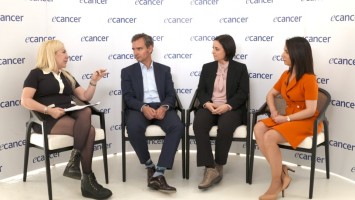BLASST-1: Combining nivolumab, gemcitabine and cisplatin for the neoadjuvant treatment of muscle invasive bladder cancer
Dr Shilpa Gupta - Case Comprehensive Cancer Center, Cleveland, USA
We are presenting the results from our bladder cancer signal seeking trial, BLASST-1 which is a neoadjuvant study of nivolumab with gemcitabine and cisplatin in muscle invasive bladder cancer patients who are undergoing radical cystectomy. This was a study that was conducted across four sites in the US and we enrolled 41 patients between February 2018 and June 2019. The eligibility criteria was for patients with T2 to T4 and N1 solitary lymph node and no metastatic disease urothelial cancer who were candidates for radical cystectomy and were eligible to receive cisplatin.
We excluded patients with creatinine clearance more than 50ml/min or other factors precluding the use of cisplatin. We treated them with four cycles of GemCis and added nivolumab on day 8 of each cycle. After that the patients underwent radical cystectomy within 6-8 weeks and the primary endpoint of the study was pathologic downstaging, that is no more muscle invasion in the specimen. So anything T1 or below at the time of surgery, that was our primary endpoint. Secondary endpoints were safety and efficacy and progression free survival at two years. We did a variety of correlatives in this study, including whole genome sequencing, molecular subtyping of the pre-treatment tissues, immune profiling – PD-L1, CD8 levels etc. – and those analyses are ongoing.
Our preliminary results show that the pathologic downstaging rates were 66% with this regimen and the regimen was safe and effective. There were no increased toxicities, most of the side effects were traditionally what we see from chemotherapy. There were some immune related adverse events but they were mild. None of the patients required steroids. There were no delays to surgery, which is a big concern with such studies, and there were no treatment related deaths.
Our downstaging rates of 66% are pretty remarkable in this setting because traditionally they are in the range of 30-40%. Our pathologic complete responders, that is pT0 or just carcinoma in situ, were around 49% which is also pretty remarkable. The combination was safe and effective and we did not see any correlation with PD-L1 status and response and other biomarkers are currently being looked at.
The implications of these findings are that immunotherapy will represent an important backbone in the neoadjuvant treatment. There is already a phase III trial going on which is looking at gemcitabine cisplatin randomised against gemcitabine cisplatin and nivolumab plus/minus IDO inhibitors. So that is a phase III trial that will answer more important questions in a randomised fashion. In that study the PFS and pathologic complete responses are primary endpoints.








